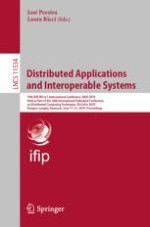2019 | Buch
Distributed Applications and Interoperable Systems
19th IFIP WG 6.1 International Conference, DAIS 2019, Held as Part of the 14th International Federated Conference on Distributed Computing Techniques, DisCoTec 2019, Kongens Lyngby, Denmark, June 17–21, 2019, Proceedings
herausgegeben von: José Pereira, Laura Ricci
Verlag: Springer International Publishing
Buchreihe : Lecture Notes in Computer Science
